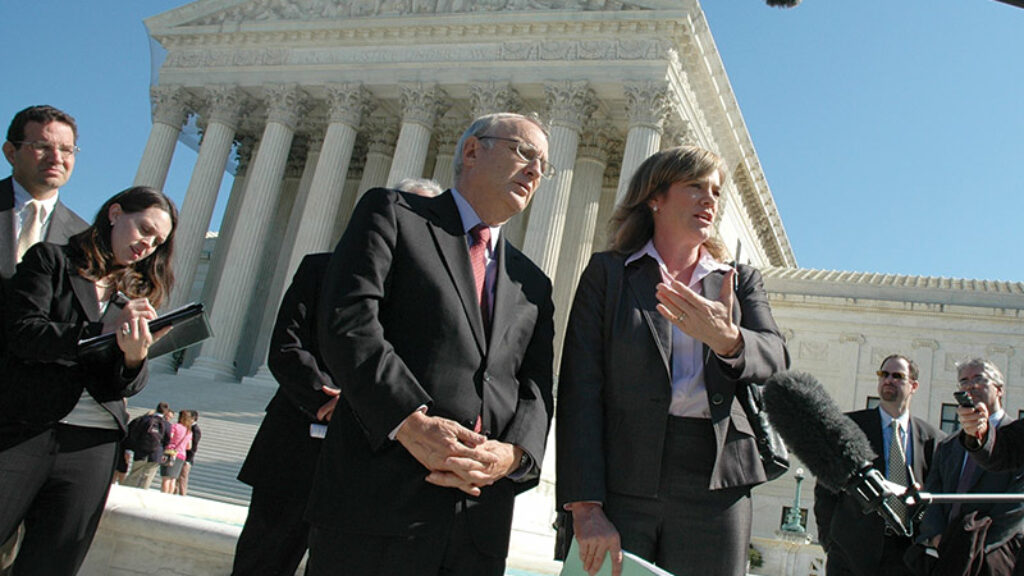Religious Freedom and Jewish Experience
Editor’s note: This essay is part of an exchange with Noah Feldman. You can read Feldman’s essay here.
Reigious liberty is back on the Supreme Court’s docket. At issue in Carson v. Makin is Maine’s tuition assistance program. Over half the school districts in Maine do not have their own secondary schools. To solve this problem, Maine allows parents in those districts to select an approved private school where the state pays the tuition. However, Maine expressly excludes sectarian schools from receiving such payments. As a result, even if such a school satisfied all the educational criteria to be a part of the program, it would be excluded because it is sectarian. According to the parents who filed suit, this sort of exclusion amounts to religious discrimination and ought to be unconstitutional under the Free Exercise Clause of the First Amendment.
Beneath this legal challenge is a claim for theological emancipation—an attempt to ensure that the very constitutional categories of religious discrimination don’t marginalize minority faith communities by enshrining the cultural assumptions of the majority. As it stands, the constitutional prohibition against excluding religion from government funding programs applies only when such discrimination is based on the status of the institution applying for funds—that is, what the institution is, such as a parochial school. But where such exclusion is based on how those funds are used—for instance, to provide a high school education—the law has equivocated.
The problem is that the intuitive appeal of the distinction between religious status and religious use relies on a largely Protestant conception of religious experience that sees faith as a matter of personal belief rather than religious conduct. Thus, religious discrimination based on institutional identity is constitutionally off limits, but religious discrimination that excludes funding of religious ritual and practice is, at least sometimes, constitutionally acceptable. This makes the stakes of Carson v. Makin particularly high for American Jews because they, along with Muslims, Catholics, and others, organize their religious lives around routine religious acts. If the Supreme Court doesn’t give up the constitutional distinction between status and use, it will essentially authorize the state of Maine, and hence, other government entities, to discriminate against religious groups in their allocation of government funds. In doing so, it will entrench majoritarian theology at the center of constitutional doctrine.
Discarding the status-use distinction is not just about dollars; it’s about making room for the religious experience of religious minorities, which is to say it is about the underlying motive for the First Amendment: to protect all forms of religious exercise from government overreach.
That Carson and other cases have made their way to the court only in recent years is no surprise. For most of the late twentieth century, government funding for religion or religious institutions was a constitutional nonstarter; maintaining separation of church and state, in the court’s eyes, prohibited all such funding. But in the early years of the twenty-first century, the Supreme Court’s doctrine shifted. Instead of viewing the Establishment Clause of the First Amendment—“Congress shall make no law respecting an establishment of religion”—as prohibiting any funding of religion, the court increasingly argued that religion could receive funding so long as it was on equal and neutral terms. So, for example, if the government made historic preservation grants available, it could give such a grant to a church just like it could give money to preserve any other historically significant building. The key was that the funds were allocated to promote a secular objective.

This shift in constitutional doctrine, however, presented another puzzle. Sure, government could provide funding to religious institutions. But what if a state remained concerned that such funding violated principles of separation of church and state? Could states decide to continue excluding religion and religious institutions from government funding programs even though the federal constitution allowed it? Or would excluding religion under such circumstances constitute religious discrimination, which itself is prohibited? After all, there is another clause in the First Amendment that prevents government from passing any law that would prohibit “the free exercise” of religion.
In 2004, when the court initially addressed this question, it seemed to grant leeway to states. Thus, in Locke v. Davey,the court allowed Washington state to exclude students pursuing degrees in devotional theology from a government-funded scholarship program. The Establishment Clause did not prohibit funding, but the Free Exercise Clause, which protects, among other things, against religious discrimination, did not require funding, because there was “play in the joints” between the two clauses.
In more recent years, however, the Supreme Court has been increasingly skeptical of this line of reasoning. The first instance of this newfound skepticism came in 2017, when the Supreme Court decided Trinity Lutheran Church of Columbia, Inc. v. Comer. Consider the facts: A church-run school sought funding from the state of Missouri to support the construction of a playground. Missouri has made such funds generally available to nonprofits. But the school, otherwise eligible for the funds on the basis of secular and neutral criteria, was denied because it was a religious institution. In the court’s view, this denial violated the First Amendment because the state of Missouri denied a church funds “simply because of what it is.”
This, of course, generated a problem. How should the court reconcile its 2017 opinion with its 2004 precedent? This is when the court introduced the “status-use distinction.” The logic goes something like this: To exclude students pursuing degrees in devotional theology from a government-sponsored scholarship program is to exclude them based on what they will use the funds for—namely, religion. But to exclude a church from using the funds for a playground is to exclude the church simply because of its religious status; unlike theological discussions of the trinity, there is nothing religious about playing on a seesaw. Thus, the status-use distinction was born.
The distinction may have helped the court make it through the day, but it is not above criticism. And not surprisingly, the court has appeared less enthusiastic about the distinction in more recent years. In Carson v. Makin, the court has expressly returned to the status-use distinction, leading some to believe that the court intends to abandon it, as it should.
To see why the status-use distinction has been under attack, we need look no further than how a federal court of appeals decided Carson v. Makin in favor of the government. According to the decision of the United States Court of Appeals for the First Circuit, Maine’s exclusion of sectarian schools was, in reality, an exclusion of schools not based on who they are but simply based on what they do. Highlighting statements by various Maine officials, the court of appeals explained that schools were excluded only based on “what the school teaches through its curriculum and related activities, and how the material is presented.” As a result, this was discrimination based on use, not based on status.
This sort of semantic gamesmanship may be the most common reason why the status-use distinction has been under attack. At bottom, status and use are permeable categories that can be manipulated to achieve preferred, but unprincipled, legal outcomes. Indeed, the most vociferous critic of the distinction, Justice Gorsuch, has made this point on a number of occasions. In one concurring opinion, he wrote, “Does a religious man say grace before dinner? Or does a man begin his meal in a religious manner?” At oral argument in Carson v. Makin, he asked the attorney representing the state of Maine, “Does the government see a basis for distinguishing between a tax on persons who wear yarmulkes as opposed to a tax on Jewish persons?”
Gorsuch’s question may sound a bit startling, but it’s actually based on a 1993 case in which the Supreme Court made a similar point about the slipperiness of distinctions between status and conduct, noting that “a tax on wearing yarmulkes is a tax on Jews.” The fact that Jewish practice would provide the court with such a ready example is far from coincidental. Indeed, it is a thread that when pulled unravels this constitutional doctrine and shows just how the status-use distinction has marginalized Jews and Jewish practice.
External religious practice, rather than private belief, stands at the center of Jewish identity. This is particularly true for Jews committed to fulfilling the commands of halakha, or Jewish law. One of the most central features of halakha is that it governs all facets of the human condition. Since it covers all areas of human conduct, Jewish law regularly infuses the performance of seemingly secular activities with religious purpose and significance. So what are courts supposed to do when it comes to applying the status-use distinction to Jewish institutions and Jewish practice?
Consider, for example, the Orthodox Union’s argument that Jewish law imposes a religious obligation to take the COVID-19 vaccine. Are we to take that to mean that states can exclude institutions serving the Jewish community from public-private vaccine funding programs because the vaccines have a religious use? Alternatively, consider Jewish law’s religious obligation that construction be done in such a way “to remove and guard oneself against any life-threatening obstacle.” States, when providing preservation grants for historic buildings, often require construction to abide by government health and safety codes. Could states withhold funds used to comply with health and safety codes from Jewish institutions because those funds are deemed to have a religious use?
Such hypothetical cases are more than just curiosities. They highlight the fundamental mismatch between the constitutional distinction and the religious experience of American Jews. In the American—and, yes, largely Protestant—imagination, the elevation of religious status as a protected form of discrimination makes complete sense. Within this worldview, religion is regarded as essentially private and internal. This makes the distinction between who one is (status) and what one does (use) seem like a plausible way to parse the Free Exercise Clause, but what about religions—including, but not only, Judaism—which regard practice as central?
The status-use distinction is far from the first constitutional distinction that appears to tilt the scales against American Jewish practice. When, in the mid-twentieth century, American Jews challenged Sunday closing laws as violations of their religious liberty, the Supreme Court rejected their claims, arguing that religious liberty protected citizens from experiencing significant burdens on their religious practice—and then concluding that Sunday closing laws merely made life “more expensive” for Jews.
In 1986, when Simcha Goldman challenged the armed forces’ prohibition against wearing a yarmulke, the Supreme Court emphasized that religious liberty claims must fail in the face of important government interests—and then rejected his claim because uniformity of dress within the armed forces satisfied that high standard. Moreover, American Jews are far from the only religious minority in the United States that has labored under constitutional distinctions that discount their religious needs and practices. One need only revisit the judicial treatment of Mormons in the nineteenth century, Native Americans in the late-twentieth century, and Muslims in the early-twenty-first century to see similar failures of constitutional reasoning and religious understanding.
If the Supreme Court remains committed to the view that excluding religion from government funding programs constitutes prohibited religious discrimination, then it should not impose distinctions that protect against status-based discrimination but permit use-based discrimination. It isn’t simply that doing so is incoherent (one court’s status is another court’s use). And it isn’t simply because the government undermines its own interests when it excludes religious institutions from funding programs that advance secular goals. It is because it further entrenches dominant forms of religious meaning and experience over others. In short, it introduces actual religious discrimination into the very concept of religious discrimination.
Suggested Reading

The First Amendment and the Vocabulary of Freedom
Oral arguments in a case involving two Catholic schools sometimes sounded less like a jurisprudential clash over the First Amendment than a synagogue kiddush.
Old Isaiah
When Woodrow Wilson became the first president to nominate a Jew for a seat on the Supreme Court, much of the opposition to his appointment revolved around his Jewishness.
Discrimination and Identity in London: The Jewish Free School Case
How Britain's highest court misunderstands Judaism.

Life and Text
Should we read our own experiences like the Zohar reads the Torah?
Comments
You must log in to comment Log In